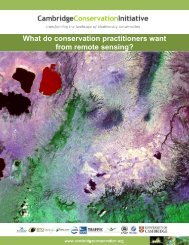CONSERVING BIODIVERSITY & DELIVERING ECOSYSTEM SERVICES
conserving biodiversity & delivering ecosystem services
conserving biodiversity & delivering ecosystem services
You also want an ePaper? Increase the reach of your titles
YUMPU automatically turns print PDFs into web optimized ePapers that Google loves.
Overall, the changes predicted to occur in the foreseeable<br />
future would have the biggest negative impact on local<br />
communities living in or near IBAs (see figure). Local<br />
climate and air quality regulation, harvested wild goods and<br />
water provision services all benefit local people who would<br />
be significantly affected by predicted patterns of change,<br />
even though some local communities may benefit by<br />
increased services from cultivation. Some benefits would<br />
also be anticipated at the local level from increased tourism.<br />
Proportion of IBAs at which delivery of the most important<br />
ecosystem services is projected to increase or decrease, and the<br />
location of the beneficiaries who will gain or lose<br />
Numbers in brackets represent the number of sites at which the service was recorded as<br />
being in the 5 most important. Only these sites are included in each column, and only<br />
services that were important at >5 sites are presented. At no site was the delivery of the 5<br />
most important ecosystem services projected to remain stable.<br />
Distribution of beneficiaries<br />
In general, for national level users there are both increases<br />
and decreases of services across sites, but national<br />
stakeholders would gain overall in relation to tourism and<br />
recreation. The global community is impacted by the ability<br />
of the sites to provide global climate regulation in the future,<br />
with results showing a fairly even balance between the<br />
numbers of sites where this service is predicted to increase<br />
(e.g. due to forest regeneration) and decrease (due to<br />
deforestation and degradation).<br />
<br />
In some situations, ecosystem service delivery may conflict<br />
with biodiversity conservation objectives. For example,<br />
SOURCE Based on information provided at an expert consultation workshop.<br />
management of a site might enhance one especially valuable<br />
service (e.g. harvesting of grasses) while having a negative impact on populations of threatened species at the site (e.g.<br />
grassland-dependent birds). There is sometimes a need for compromise between delivering key ecosystem services and<br />
maintaining important biodiversity, without the former becoming a serious threat to biodiversity and / or being unsustainable<br />
in the longer term.<br />
An example from Phulchoki Mountain Forests IBA<br />
Phulchoki Mountain Forests is an IBA which lies 16 km south-east of Kathmandu. It has significant populations of key forest<br />
bird species and a huge diversity of threatened orchids. It is also important for many ecosystem services including<br />
harvested wild goods, nature-based recreation and water provision.<br />
Historically, the lower slopes of the forest were heavily degraded, much as on other hills surrounding the Kathmandu<br />
Valley. However, the state of the forests at Phulchoki has improved following the establishment of community forestry<br />
some 15 years ago, in clear contrast to the surrounding degraded and converted land. In this case, restoration of the forests<br />
and handing over the management to community Forest User Groups (FUG) has enabled local people to capture (and<br />
control) many of the direct benefits from harvested wild goods and from recreational visitors, as well as receive the benefits<br />
from improved water quality compared to previously. Many of these benefits have been realised by women in the<br />
community, who are responsible for collecting the harvested wild goods and water for their families. These increased<br />
benefits are being realised at the cost of reduced agricultural production (which has affected immigrant settlers) and<br />
production of timber and charcoal (affecting mainly traders servicing the demand from Kathmandu). For example, in the<br />
past heavy use of forest resources was made by Kami (blacksmiths) and Sunar (goldsmiths) castes, from forest-adjacent<br />
communities and from further afield, for the production of charcoal. These people no longer have access unless they are<br />
living locally and are members of a Forest User Group.<br />
“We collect fuel wood from the forest. We also collect grass to feed our cattle and make compost.<br />
So we are benefiting from the forest in many ways. The cool wind that blows from the forest is<br />
good for everyone. Thanks to the forest we get a regular supply of water, otherwise the streams<br />
would have dried up. Now all the streams are flowing. People come here to watch the beautiful<br />
scenery and birds. Many people from Kathmandu also come for picnics” says Ganesh Bahadur<br />
Silwal, President of the Godawari Kunda FUG.<br />
For more details of this study, see p.31.




